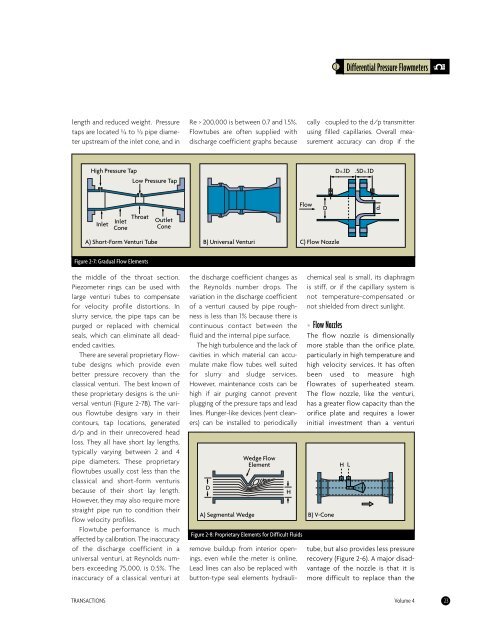flow and level measurement - Omega Engineering
flow and level measurement - Omega Engineering
flow and level measurement - Omega Engineering
Create successful ePaper yourself
Turn your PDF publications into a flip-book with our unique Google optimized e-Paper software.
length <strong>and</strong> reduced weight. Pressure<br />
taps are located G to H pipe diameter<br />
upstream of the inlet cone, <strong>and</strong> in<br />
High Pressure Tap<br />
Inlet<br />
Inlet<br />
Cone<br />
Figure 2-7: Gradual Flow Elements<br />
Low Pressure Tap<br />
Throat Outlet<br />
Cone<br />
the middle of the throat section.<br />
Piezometer rings can be used with<br />
large venturi tubes to compensate<br />
for velocity profile distortions. In<br />
slurry service, the pipe taps can be<br />
purged or replaced with chemical<br />
seals, which can eliminate all deadended<br />
cavities.<br />
There are several proprietary <strong>flow</strong>tube<br />
designs which provide even<br />
better pressure recovery than the<br />
classical venturi. The best known of<br />
these proprietary designs is the universal<br />
venturi (Figure 2-7B). The various<br />
<strong>flow</strong>tube designs vary in their<br />
contours, tap locations, generated<br />
d/p <strong>and</strong> in their unrecovered head<br />
loss. They all have short lay lengths,<br />
typically varying between 2 <strong>and</strong> 4<br />
pipe diameters. These proprietary<br />
<strong>flow</strong>tubes usually cost less than the<br />
classical <strong>and</strong> short-form venturis<br />
because of their short lay length.<br />
However, they may also require more<br />
straight pipe run to condition their<br />
<strong>flow</strong> velocity profiles.<br />
Flowtube performance is much<br />
affected by calibration. The inaccuracy<br />
of the discharge coefficient in a<br />
universal venturi, at Reynolds numbers<br />
exceeding 75,000, is 0.5%. The<br />
inaccuracy of a classical venturi at<br />
Re > 200,000 is between 0.7 <strong>and</strong> 1.5%.<br />
Flowtubes are often supplied with<br />
discharge coefficient graphs because<br />
A) Short-Form Venturi Tube B) Universal Venturi C) Flow Nozzle<br />
the discharge coefficient changes as<br />
the Reynolds number drops. The<br />
variation in the discharge coefficient<br />
of a venturi caused by pipe roughness<br />
is less than 1% because there is<br />
continuous contact between the<br />
fluid <strong>and</strong> the internal pipe surface.<br />
The high turbulence <strong>and</strong> the lack of<br />
cavities in which material can accumulate<br />
make <strong>flow</strong> tubes well suited<br />
for slurry <strong>and</strong> sludge services.<br />
However, maintenance costs can be<br />
high if air purging cannot prevent<br />
plugging of the pressure taps <strong>and</strong> lead<br />
lines. Plunger-like devices (vent cleaners)<br />
can be installed to periodically<br />
D<br />
A) Segmental Wedge<br />
Wedge Flow<br />
Element<br />
Figure 2-8: Proprietary Elements for Difficult Fluids<br />
remove buildup from interior openings,<br />
even while the meter is online.<br />
Lead lines can also be replaced with<br />
button-type seal elements hydrauli-<br />
2 Differential Pressure Flowmeters<br />
cally coupled to the d/p transmitter<br />
using filled capillaries. Overall <strong>measurement</strong><br />
accuracy can drop if the<br />
chemical seal is small, its diaphragm<br />
is stiff, or if the capillary system is<br />
not temperature-compensated or<br />
not shielded from direct sunlight.<br />
• Flow Nozzles<br />
The <strong>flow</strong> nozzle is dimensionally<br />
more stable than the orifice plate,<br />
particularly in high temperature <strong>and</strong><br />
high velocity services. It has often<br />
been used to measure high<br />
<strong>flow</strong>rates of superheated steam.<br />
The <strong>flow</strong> nozzle, like the venturi,<br />
has a greater <strong>flow</strong> capacity than the<br />
orifice plate <strong>and</strong> requires a lower<br />
initial investment than a venturi<br />
tube, but also provides less pressure<br />
recovery (Figure 2-6). A major disadvantage<br />
of the nozzle is that it is<br />
more difficult to replace than the<br />
TRANSACTIONS Volume 4 23<br />
H<br />
Flow<br />
D<br />
B) V-Cone<br />
D±.1D .5D±.1D<br />
H L<br />
d

















